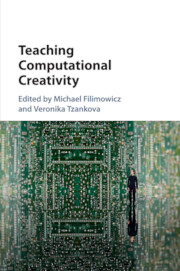Book contents
- Teaching Computational Creativity
- Teaching Computational Creativity
- Copyright page
- Contents
- Figures
- Tables
- Notes on Contributors
- Acknowledgments
- Introduction: Pedagogies at the Intersection of Disciplines
- PART I NEW FOUNDATIONS
- PART II CODE AS MEDIUM
- 3 ARRAY[ ]: Coding Slowly
- 4 Teaching for the Design Singularity: Toward an Entirely Code-based Design Curriculum
- PART III PHYSICAL{LY} COMPUTING
- PART IV ONLINE LEARNING
- PART V CRITICAL PEDAGOGY
- PART VI TRANSDISCIPLINARY
- Interviews
- Afterword: Toward a Curricular Synthesis
- Index
- References
4 - Teaching for the Design Singularity: Toward an Entirely Code-based Design Curriculum
from PART II - CODE AS MEDIUM
Published online by Cambridge University Press: 04 July 2017
- Teaching Computational Creativity
- Teaching Computational Creativity
- Copyright page
- Contents
- Figures
- Tables
- Notes on Contributors
- Acknowledgments
- Introduction: Pedagogies at the Intersection of Disciplines
- PART I NEW FOUNDATIONS
- PART II CODE AS MEDIUM
- 3 ARRAY[ ]: Coding Slowly
- 4 Teaching for the Design Singularity: Toward an Entirely Code-based Design Curriculum
- PART III PHYSICAL{LY} COMPUTING
- PART IV ONLINE LEARNING
- PART V CRITICAL PEDAGOGY
- PART VI TRANSDISCIPLINARY
- Interviews
- Afterword: Toward a Curricular Synthesis
- Index
- References
Summary
We can all attest to the fact that digital technologies of all kinds – both hardware and software – are becoming increasingly integrated into both our individual lives and society as a whole. At the forefront of this phenomenon is the contemporary maker movement (a “design singularity” of sorts), which promises to democratize and extend the means of design production to nearly everyone with interest. This movement, however, has significant implications for the profession of design, as the democratization of technologies prompts a questioning of the role of those who had previously (and exclusively) engaged with those technologies. If the conventional means of design production are made accessible to non-designers, then in what activities should the professional designer be engaged? As one potential response to this question, this contribution to Teaching Computational Creativity begins to establish an argument for developing design curricula that are “entirely code-based,” referring to the high degree to which code-relevant principles and activities inform the entirety of the design processes students are exposed to. Design and code are uniquely positioned for forming this curricular relationship, as they share a number of key core elements that would potentially enable the use of code as a medium for both teaching and executing design.
- Type
- Chapter
- Information
- Teaching Computational Creativity , pp. 95 - 104Publisher: Cambridge University PressPrint publication year: 2017



